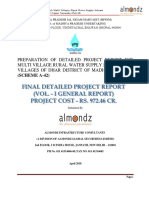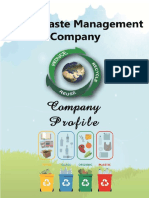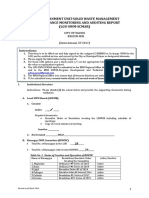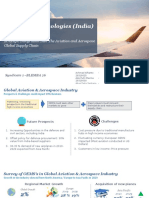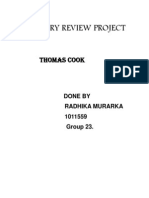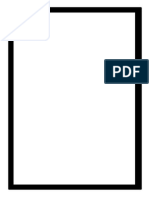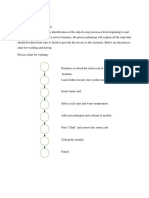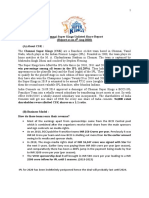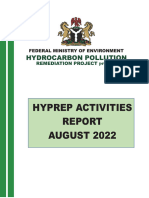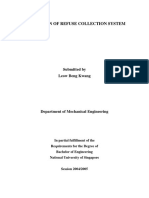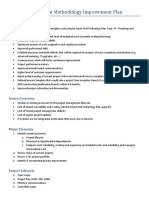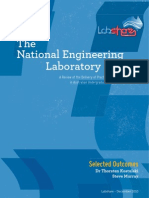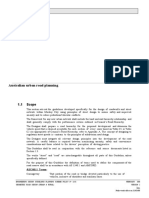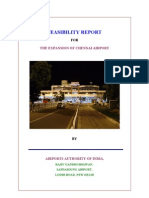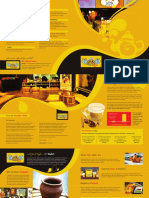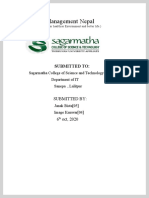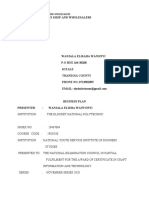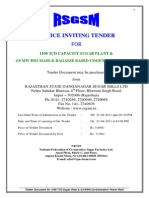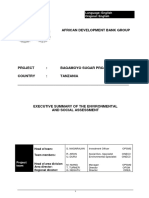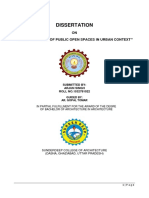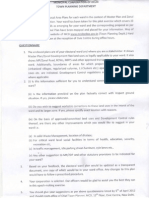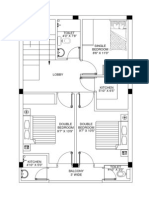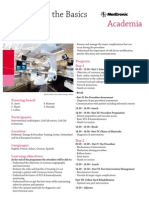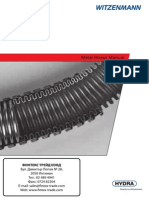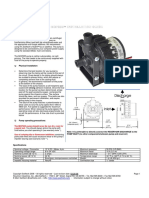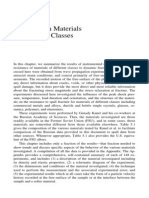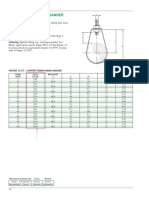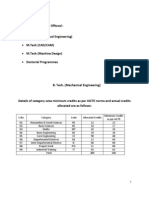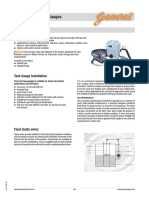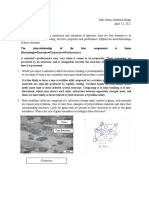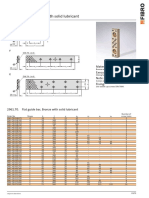0 ratings0% found this document useful (0 votes)
332 viewsCity Garbage - Janakpuri A-Block
City Garbage - Janakpuri A-Block
Uploaded by
Mohit GuptaThis document is a dissertation submitted by Mohit Gupta to fulfill requirements for a Master of Architecture degree in Urban Regeneration. It examines domestic waste management in Janakpuri, New Delhi through a case study and analysis of waste collection sites. The study finds low levels of household awareness and segregation of waste. Recommendations are provided to improve the garbage collection procedure, transportation, and disposal methods.
Copyright:
© All Rights Reserved
Available Formats
Download as PDF, TXT or read online from Scribd
City Garbage - Janakpuri A-Block
City Garbage - Janakpuri A-Block
Uploaded by
Mohit Gupta0 ratings0% found this document useful (0 votes)
332 views25 pagesThis document is a dissertation submitted by Mohit Gupta to fulfill requirements for a Master of Architecture degree in Urban Regeneration. It examines domestic waste management in Janakpuri, New Delhi through a case study and analysis of waste collection sites. The study finds low levels of household awareness and segregation of waste. Recommendations are provided to improve the garbage collection procedure, transportation, and disposal methods.
Original Description:
A dissertation on solid waste management in Janakpuri, Delhi.
Copyright
© © All Rights Reserved
Available Formats
PDF, TXT or read online from Scribd
Share this document
Did you find this document useful?
Is this content inappropriate?
This document is a dissertation submitted by Mohit Gupta to fulfill requirements for a Master of Architecture degree in Urban Regeneration. It examines domestic waste management in Janakpuri, New Delhi through a case study and analysis of waste collection sites. The study finds low levels of household awareness and segregation of waste. Recommendations are provided to improve the garbage collection procedure, transportation, and disposal methods.
Copyright:
© All Rights Reserved
Available Formats
Download as PDF, TXT or read online from Scribd
Download as pdf or txt
0 ratings0% found this document useful (0 votes)
332 views25 pagesCity Garbage - Janakpuri A-Block
City Garbage - Janakpuri A-Block
Uploaded by
Mohit GuptaThis document is a dissertation submitted by Mohit Gupta to fulfill requirements for a Master of Architecture degree in Urban Regeneration. It examines domestic waste management in Janakpuri, New Delhi through a case study and analysis of waste collection sites. The study finds low levels of household awareness and segregation of waste. Recommendations are provided to improve the garbage collection procedure, transportation, and disposal methods.
Copyright:
© All Rights Reserved
Available Formats
Download as PDF, TXT or read online from Scribd
Download as pdf or txt
You are on page 1of 25
DISSERTATION-I
CITY GARBAGE TREASURE OR WASTE
Submitted in partial fulfilment of the
requirement for the award of degree of
Master of Architecture (Urban Regeneration)
Submitted by
Mohit Gupta
Guided by
Ar. Nisar khan
Ar. J.P.Singh
FACULTY OF ARCHITECTURE & EKISTICS
JAMIA MILLIA ISLAMIA
NEW DELHI-110025
2013-2014
Faculty of Architecture & Ekistics,
Jamia Millia Islamia, New Delhi
Certificate
In the partial fulfilment of the M. Arch degree program, this is to certify that Mohit gupta
has worked on the dissertation report entitled CI TY GARBAGE TREASURE OR WASTE
under my guidance and supervision.
Ar. Nisar Khan Prof. S.M.Akhtar
Dissertation Guide (Dean)
Ar. J.P.Singh Ar. Abdul Halim babbu
Dissertation Guide H.O.D.
External Examiner 1 External Examiner 2
CITY GARBAGE TREASURE OR WASTE 2013-14
ii
MOHIT GUPTA M ARCH I SEM F/O ARCHITECTURE & EKISTICS, JMI, NEW DELHI
DECLARATION
I, MOHIT GUPTA hereby declares that the dissertation entitled CI TY GARBAGE
TREASURE OR WASTE submitted in the partial fulfilment of the requirements for the award
of the degree of Masters of Architecture is my original design/ research work and that the
information taken from secondary sources is given due citations and references.
Date:____________ Mohit Gupta
Place: ___________ M-Arch, Sem 1
Urban Regeneration
CITY GARBAGE TREASURE OR WASTE 2013-14
iii
MOHIT GUPTA M ARCH I SEM F/O ARCHITECTURE & EKISTICS, JMI, NEW DELHI
ACKNOWLEDGEMENT
I am highly obliged and indebted to my research guide AR.J.P.SINGH & AR.NISAR KHAN for
his support and help extended during the course of study.
AR.NISAR KHAN, Faculty of Architecture and Ekistics, JAMIA MILLIA ISLAMIA inspired
me to cover this project in my course. He helped me in collecting the pearls of wisdom from
different sources, arranging them in a systematic manner and in removing the cobwebs whenever
they appeared. He was always there to inspire me to remain focused in my mission. He was a
source of immense strength in the preparation and completion of this project for which I am
deeply gratified to him.
My special gratitude to Librarian, Faculty of Architecture and Ekistics for his steady support in
giving me appropriate information all the time.
With due regards, I express my heartfelt gratitude to my parents and other family members for
their unconditional support in carrying out the present endeavour.
Last but not the least; I would like to thank my friend Nomaan khan, Manu Agarwal and Zeeshan
Ibrar for their patience and at times innovative ideas during the compilation of the project.
MOHIT GUPTA
M.ARCH I sem
F/O ARCHITECTURE AND EKISTICS,
JAMIA MILLIA ISLAMIA
CITY GARBAGE TREASURE OR WASTE 2013-14
iv
MOHIT GUPTA M ARCH I SEM F/O ARCHITECTURE & EKISTICS, JMI, NEW DELHI
CONTENTS
1 INTRODUCTION AND OVERVIEWS ............................................................................... 1
1.1 The Problem ..................................................................................................................... 1
1.2 Aims & Objective of the study ......................................................................................... 3
1.3 Research method .............................................................................................................. 3
2 CONCEPTS OF DOMESTIC WASTE MANAGEMENT ................................................... 4
2.1 Domestic Solid Waste Management ................................................................................ 4
2.2 Re-use & Recycling ......................................................................................................... 4
2.3 Waste Prevention, Collection & Treatment ..................................................................... 5
2.4 Status of MSW in India .................................................................................................... 6
3 CASE STUDY JANAKPURI (A BLOCK), NEW DELHI ............................................. 7
3.1 Introduction ...................................................................................................................... 7
3.2 Area Selection .................................................................................................................. 8
3.2.1 Location of Dhalaos / Receptacles ............................................................................ 9
3.2.2 Condition of Dhalaos / Receptacles ........................................................................ 10
4 ISSUES................................................................................................................................. 14
4.1 Segregation of waste ...................................................................................................... 14
4.2 Classification of Wastes:-............................................................................................... 14
5 RECOMMENDATIONS ..................................................................................................... 15
5.1 Garbage Collection Procedure ....................................................................................... 15
5.2 Transportation of Garbage ............................................................................................. 16
5.3 Disposal of Waste........................................................................................................... 17
CITY GARBAGE TREASURE OR WASTE 2013-14
v
MOHIT GUPTA M ARCH I SEM F/O ARCHITECTURE & EKISTICS, JMI, NEW DELHI
TABLE OF FIGURES
Figure 1-1 DELHIS GARBAGE COLLECTION ......................................................................... 2
Figure 2-1 RE-USE AND RECYCLING ..................................................................................... 4
Figure 2-2 EVOLUTION OF WASTE ....................................................................................... 5
Figure 2-3 MSW GENERATE IN INDIA .................................................................................. 6
Figure 3-1 MAP OF INDIA .................................................................................................... 7
Figure 3-2 ZONAL MAP OF DELHI ........................................................................................ 7
Figure 3-3 ILLUSTRATIVE MAP OF JANAKPURI A-BLOCK .................................................... 7
Figure 3-4 JANAKPURI A-BLOCK MAP .................................................................................. 8
Figure 3-5 LOCATION OF DHALAOS IN JANAKPURI WEST (A-BLOCK) ................................. 9
Figure 3-6 (AUTHOR) PANKHA ROAD ............................................................................. 10
Figure 3-7 (AUTHOR) A1 MARKET .................................................................................. 10
Figure 3-8 (AUTHOR) A2 MOTA SINGH ........................................................................... 10
Figure 3-9 (AUTHOR) - POSANGIPUR................................................................................. 11
Figure 3-10 (AUTHOR)- CHANDER NAGAR ........................................................................ 11
Figure 3-11 (AUTHOR) D.T.E.A. SCHOOL ........................................................................ 11
Figure 3-12 (AUTHOR) TAXI STAND ................................................................................ 12
Figure 3-13 (AUTHOR) - A-5/A GAS GODWN ..................................................................... 12
Figure 3-14 (AUTHOR) - ASALATPUR ................................................................................. 12
Figure 5-1 GARBAGE COLECTION ...................................................................................... 16
Figure 5-2 (AUTHOR) GARBAGE COLLECTION ................................................................... 16
Figure 5-3 DISPOSAL OF WASTE ........................................................................................ 17
CITY GARBAGE TREASURE OR WASTE 2013-14
vi
MOHIT GUPTA M ARCH I SEM F/O ARCHITECTURE & EKISTICS, JMI, NEW DELHI
SUMMARY
The aim of this study was to examine the factors influencing households awareness and
participation in domestic waste disposal and recycling, focusing on environmental educational.
The study was carried out from Janakpuri District, Delhi.
A literature review was showed, covering concepts of domestic waste management waste
prevention, collection, recycling and reuse, followed by household analysis using observed data.
The analysis shows that there is a low level of household awareness about the environmental
implications of domestic waste management in Delhi region and hence low level of participation
in domestic waste sorting, disposal and recycling.
CITY GARBAGE TREASURE OR WASTE 2013-14
1 INTRODUCTION AND OVERVIEWS
The quantity of municipal solid wastes generated in Delhi has been constantly rising over the
years. This can be credited to the rapid population growth, mass migration of population from
rural to urban areas, increase in economic activities in general in the city and the change in
lifestyle of the people. According to the Population Census 2001, the highest percentage of urban
population in India is in Delhi (93.01%). Change in lifestyle of the people has resulted in
increased wasteful consumption, leading to a change in the composition and increase in the
quantum of solid waste generated.
Urban solid waste is normally a complex mixture of household, construction, commercial, toxic
industrial elements and hospital wastes. On an average, Delhi generates 4000 tonnes of
municipal solid waste per day. It consists of about 32% compostable matter. The recyclable
components include paper 6.6%, plastics 1.5% and metals 2.5%. Primarily the responsibility of
solid waste management is vested upon several public sector agencies. However, various other
stakeholder groups, such as rag pickers, waste dealers, recyclers and recycling unit workers play
significant roles in the overall scheme of things.
1.1 The Problem
1
Growing by tons and mounds, Delhis garbage crisis may soon reach its breaking point.
Three of the four stinking waste mountains (landfills) are long overdue for closure and there are
no fresh landfills available to take in the current daily discard of 9,000 tonnes. Since as much as
85% of the city doesnt have a formal door-to-door trash pick-up system, the emerging scenario
is both worrisome and scary.
The 2,500-odd filthy community bins (dhalaos) that serve as secondary collection centers for the
three municipal bodies in thousands of colonies will start overflowing, and garbage will spill on
to the streets. Residents will have no option but to start throwing waste out.
1
Hindustan Times Delhi may drown its own waste - http://www.hindustantimes.com/news-feed/chunk-ht-ui-
indiasectionpage-htfordelhi/delhi-may-drown-in-its-own-waste/article1-1052381.aspx
CITY GARBAGE TREASURE OR WASTE 2013-14
2
MOHIT GUPTA M ARCH I SEM F/O ARCHITECTURE & EKISTICS, JMI, NEW DELHI
People in Delhi are also bitterly opposed to new landfills coming up in their neighborhood as
they have seen the authorities did not maintain the past ones scientifically, turning them into
massive, polluting heaps. The black thick liquid, leachate, created when rainwater filters down
through the landfill, has made the soil highly toxic. Rainwater runoff goes into surface water
drains while methane poisons the air.
Delhis non-dumping options to manage waste have also shrunk drastically. Burning waste no
longer seems viable because of
environmental concerns and poor segregation
of waste. Compost plants are not doing well
because manure doesnt sell, and again
becomes garbage.
As much as 50% of the waste is fit for
composting. About 30 per cent of it can be
recycled. Effective segregation at source, in
transit and during disposal, will mean only
20 per cent of the refuse is needed to be sent
to the landfill site. This will also mean a
cleaner city with fewer dhalaos, garbage
trucks and longer lifespan for landfills. But
instead of proper segregation, only random
picking continues.
Delhi has miserably failed to manage its
waste load. Only 15 per cent of R1,350 crore
that the three corporations spend on waste
management and sanitation is spent on
actual disposal. The rest goes into collection
and transportation.
The authorities must ensure segregation and promote composting and recycling. They must
quantify waste generation for setting effective reduction targets. But dont wait for the authorities
to do everything.
Figure 1-1 DELHIS GARBAGE COLLECTION
http://www.hindustantimes.com/news-feed/chunk-ht-ui-
indiasectionpage-htfordelhi/delhi-may-drown-in-its-own-
waste/article1-1052381.aspx
CITY GARBAGE TREASURE OR WASTE 2013-14
3
MOHIT GUPTA M ARCH I SEM F/O ARCHITECTURE & EKISTICS, JMI, NEW DELHI
The problem of this study is the growing trend of city pollution in Delhi through inappropriate
waste management which is becoming evident in the Delhi Metropolitan Area (DMA). Large
parts of Delhi, especially poorer settlements, are becoming untidy due to improper domestic
waste disposal and low participation in domestic waste recycling. This situation is becoming
obvious particularly in the impulsive settlements and around the city outskirts, which poses
various environmental problems. This study investigates the role of environmental education,
location of suburb and wealth in determining household participation in domestic waste disposal
and recycling in Delhi Municipality Area.
1.2 Aims & Objective of the study
Defining and elaborating the meaning of GARBAGE or Municipal Solid Waste?
Describe the contents of MSW?
Explain how we use landfilling, incinerating and composting to dispose of our garbage?
Recycling the waste
1.3 Research method
How much garbage and trash (municipal solid waste) do Indians produce a year?
What are the ways in which municipalities dispose of their garbage and trash?
Of what kind of material is most of our garbage and trash composed?
How is recycling helping our landfills?
Is it possible to separate the biodegradable & degradable waste on the household level?
CITY GARBAGE TREASURE OR WASTE 2013-14
4
MOHIT GUPTA M ARCH I SEM F/O ARCHITECTURE & EKISTICS, JMI, NEW DELHI
2 CONCEPTS OF DOMESTIC WASTE MANAGEMENT
Also known as "municipal solid waste", domestic waste is waste that is generated as a result of
the ordinary day-to-day use of a domestic premise and either:-
1. Taken from the premises by or on behalf of the person who generated the waste; or
2. Collected by or on behalf of a local government as part of a waste collection and disposal
system.
2.1 Domestic Solid Waste Management
Domestic solid waste management encompasses the full range of management activities for
domestic waste streams from the point of generating the waste to the point of disposal. These
activities largely focus on resource recovery, which includes all the activities entailed in waste
segregation, collection and processing, which are carried out taking into consideration economic
viability of the material that is being recovered, e.g. for re-use and recycling.
2.2 Re-use & Recycling
In this study, re-use and recycling are conceptualized as processes which provide an opportunity
to capture some of the values from waste. Of the two concepts, re-use is a simpler technique
involving the re-utilisation of material in Its end-use form without the necessity of further value
addition or reprocessing. Recycling on the other hand, involves processing waste through
conversion of parts or all of the waste into other useful material or to recover the original raw
matter. While recycling and re-use provide an opportunity to regain residual value of waste
material, or transform waste into usable raw materials, the resource requirements (energy, human
resources, etc.) may sometimes be very great. These resource requirements can be greatly
reduced through waste prevention, collection and treatment.
Figure 2-1 RE-USE AND RECYCLING
http://peopleagainstsingleuseplastic.blogspot.in/
CITY GARBAGE TREASURE OR WASTE 2013-14
5
MOHIT GUPTA M ARCH I SEM F/O ARCHITECTURE & EKISTICS, JMI, NEW DELHI
2.3 Waste Prevention, Collection & Treatment
Waste prevention is defined as all the activities and efforts of individuals and/or groups of
individuals undertaken to minimize the volume of domestic waste generated, or generate waste
in a form that facilitates easy collection, treatment and recycling). The collection of waste and its
recovery from different waste generating points is carried out by many agents such as formal and
informal, which may represent a variety of organization structure and relationships.
Figure 2-2 EVOLUTION OF WASTE
In developing countries, solid waste management comes under the auspices of municipal bodies,
which are the formal bodies responsible for the collection, removal and disposal of garbage from
public places, and for the maintenance of dumping grounds.
Specific areas of action on improving the efficiency of waste management include:
Waste prevention, minimization and waste detoxification;
Waste collection, transfer, transport and storage; and
Waste treatment, including waste disposal.
In the developed countries, different technologies may be available for waste treatment and
recycling. Generally, four main groups of waste treatment methods exist. These include:
Biological Treatment
Incineration
Landfilling
Dumping
http://peopleagainstsingleuseplastic.blogspot.in/
CITY GARBAGE TREASURE OR WASTE 2013-14
6
MOHIT GUPTA M ARCH I SEM F/O ARCHITECTURE & EKISTICS, JMI, NEW DELHI
2.4 Status of MSW in India
Solid waste management is one among the fundamental and essential services provided by
municipal authorities in the country to keep urban centers clean. Solid waste management has
always been a serious problem for cities throughout the world.
Figure 2-3 MSW GENERATE IN INDIA
Modern civilization has brought a lot of luxuries and conveniences to our lives. However, with
all of the amenities that modern life brings us, they also cause us to contribute to producing a
large quantity of trash that needs to be taken care of. Solid waste management is an integral
element of modern society.
http://www.greenarth.com/blog/wp-content/uploads/2012/08/May-Waste-generation-Top-10-cities.png
CITY GARBAGE TREASURE OR WASTE 2013-14
7
MOHIT GUPTA M ARCH I SEM F/O ARCHITECTURE & EKISTICS, JMI, NEW DELHI
3 CASE STUDY JANAKPURI (A BLOCK), NEW DELHI
3.1 Introduction
In the municipal solid waste generated in Indian cities, Delhis position is second. Janakpuri is a
main residential area in West Delhi. It is one of the most well planned and wealthy areas of West
Delhi popular for big sized luxury villas and residential plots. The area started to develop in the
1970s. In recent years it has gained good popularity with residents of West Delhi for it houses
the commercial complex of District Centre along with various government offices and other
businesses. It is one of the most peaceful and calm residential areas of Delhi and is also known
as Colony of Parks. The total MSW disposal of the entire zone around 2500 Tonnes per day.
Janakpuri Area
Zone - G
Sub Zone No. - 13
Area 681 H
Total Waste Generated
121 Tonnes/day
(including Cantt. Area)
Figure 3-1 ZONAL MAP OF DELHI
Figure 3-3 ILLUSTRATIVE MAP OF JANAKPURI (DELHI) WEST
DELHI
Figure 3-2 MAP OF INDIA
http://www.topnews.in/files/delhi-india-map1.jpg
http://www.mapsofworld.com/
http://www.wikimapia.com
CITY GARBAGE TREASURE OR WASTE 2013-14
8
MOHIT GUPTA M ARCH I SEM F/O ARCHITECTURE & EKISTICS, JMI, NEW DELHI
3.2 Area Selection
Figure 3-4 JANAKPURI A-BLOCK MAP
Total Population of Janakpuri West(A-Block) 38922
As per MPD-2021, 0.68 Per Kg Per Capita per Day waste is generated.
Total MSW Generated in Janakpuri West(A-Block) 26.42 Tonnes Per Day.
Total no. of Dhalaos (Receptacles) in Janakpuri West(A-Block) 12
2
,
Are as follows :-
o A-1 Pankha Road
o A-1 Near Market
o A-1 Block, Opposite MCD School
o A-3 Block Near Market
o A-2 Block
o A-2 Mota Singh
o Posangipur
o Chander Nagar
o D.T.E.A. School
o A-5/A Gas Godown
o Asalatpur
2
www.mcdonline.gov.in
http://www.mapsofindia.com/delhi/maps/block-a-jankpuri.jpg
CITY GARBAGE TREASURE OR WASTE 2013-14
9
MOHIT GUPTA M ARCH I SEM F/O ARCHITECTURE & EKISTICS, JMI, NEW DELHI
3.2.1 Location of Dhalaos / Receptacles
Figure 3-5 LOCATION OF DHALAOS IN JANAKPURI WEST (A-BLOCK)
- Dhalaos (Receptacles) position in Janakpuri West(A-Block), Zone-G, Ward No. 117
http://www.wikimapia.com
http://www.wikimapia.com
CITY GARBAGE TREASURE OR WASTE 2013-14
10
MOHIT GUPTA M ARCH I SEM F/O ARCHITECTURE & EKISTICS, JMI, NEW DELHI
3.2.2 Condition of Dhalaos / Receptacles
1. 173/117 - A-1 PANKHA ROAD
Only 25% of garbage is cleaned up from this site. Rest are
remaining as it is on this dhalao. MCD defines zero time
garbage but there is not a single minute when the Dhalao is
cleaned up. A very tidy condition of receptacle creates terror
while working inside it. Garbage comes at the main road
influence the traffic.
2. 174/117 - A-1 NEAR MARKET
The condition of 174 no. is quite better due to the nearby
market area. Daily around 4 MCD Vans carried garbage
from this receptacle. There is a door-to-door service in A-1
pocket. Some houses put their waste by themselves. Two
Street corner bins are placed adjacent to the dhalao. Market
people complained MCD for the foul smell of dhalao.
3. 175/117 - A-1 BLOCK OPPOSITE MCD SCHOOL Non Operational
4. 176/117 A-3 BLOCK NEAR MARKET Non Operational
5. 177/117 A-2 BLOCK Non Operational
6. 178/117 A-2 MOTA SINGH
Garbage van came daily for lifting up the waste.
Condition of this dhalao is quite better. Private rag
pickers, which are not legalized from AIKMM are also
came there & picked up their usable material.
Figure 3-6 (AUTHOR) PANKHA ROAD
Figure 3-7 (AUTHOR) A1 MARKET
Figure 3-8 (AUTHOR) A2 MOTA SINGH
CITY GARBAGE TREASURE OR WASTE 2013-14
11
MOHIT GUPTA M ARCH I SEM F/O ARCHITECTURE & EKISTICS, JMI, NEW DELHI
7. 179/117 POSANGIPUR
This dhalao came under Posangipur village of
population around 3000 people. Due to the
proper connectivity and through easy
approach, this dhalao is updated with respect
to its time value.
8. 180/117 CHANDER NAGAR
This is the biggest dhalao in the Janakpuri
area. Daily around 4 garbage collecting trucks
carrying waste from here. After segregating the
degradable, the rest waste is going through the
Bhalswa Landfill. Rest waste is cleared by the
mechanical sweeping.
9. 181/117 D.T.E.A. SCHOOL
The condition of the dhalao is good but the
surrounding suffers due to improper segregation
and the toilet block adjacent to the dhalao. A
mixed foul smell is always there and no
alternative or come across.
Figure 3-9 (AUTHOR) - POSANGIPUR
Figure 3-10 (AUTHOR)- CHANDER NAGAR
Figure 3-11 (AUTHOR) D.T.E.A. SCHOOL
CITY GARBAGE TREASURE OR WASTE 2013-14
12
MOHIT GUPTA M ARCH I SEM F/O ARCHITECTURE & EKISTICS, JMI, NEW DELHI
10. 182/117 TAXI STAND
A dhalao near the taxi stand of Janakpuri West (A-Block) is
in very poor condition. A depilated structure named dhalao
is there to collect the garbage. In monsoon, all trash became
waste just for the non-shading structure. Commuters feel to
hide themselves on the taxi stand.
11. 183/117 A-5/A GAS GODWN
A receptacle near the gas godwn mostly filled up with the
industrial and medical wastes. A hospital is just opposite to the
gas godwn. Very few rag pickers come over there for
segregation. This dhalao mostly filled with the inorganic waste
like batteries, cells, containers etc.
12. 184/117 ASALATPUR
Dhalao No. 184 is at the Asalatpur Village of Janakpuri
West (A-Block). The dhalao is in good condition. No
street corner bins are there. People throw their waste in an
improper way but the managing teams puts the great
efforts to clean up the receptacle.
Figure 3-12 (AUTHOR) TAXI STAND
Figure 3-13 (AUTHOR) - A-5/A GAS GODWN
Figure 3-14 (AUTHOR) - ASALATPUR
CITY GARBAGE TREASURE OR WASTE 2013-14
13
MOHIT GUPTA M ARCH I SEM F/O ARCHITECTURE & EKISTICS, JMI, NEW DELHI
CONCLUSION
The overall conditions of dhalaos(receptacles) of Janakpuri West is in adequate manner.
The process of collection and transportation is worked in a proper way but the the method
of segregation is very poor.
Government charging the rag pickers who segregate the waste privately or they are not
legalized from AIKMM.
People of the janakpuri were not segregate their waste properly in dry waste and wet
waste through which the usable waste for rag pickers has become no use.
Dhalao no. 175,176 and 177 which are non-operational, people put their waste at those
vacant lands even after demolishing the dhalaos.
GPS based traction system is in transportation vehicle has been introduced.
There is a mixed composition in the solid waste of Janakpuri Area. It includes:
Food & Garden Waste 40%
Glass & Ceramic Waste 5%
Metal 3%
Inert 15%
Plastic/ Rubber 4%
Textile 6%
Paper 27%
CITY GARBAGE TREASURE OR WASTE 2013-14
14
MOHIT GUPTA M ARCH I SEM F/O ARCHITECTURE & EKISTICS, JMI, NEW DELHI
4 ISSUES
4.1 Segregation of waste
The waste dumped in community bins is a mixed type of waste, i.e. all types of waste
biodegradable, recyclable, inert & non- biodegradable waste is found in one bin, which become
very hard to manage. Following table shows Varity of waste material generally found in a
dustbin.
4.2 Classification of Wastes:-
Biodegradable Wastes Non-Biodegradables Wastes
S.no. Organic Waste Inorganic Waste Recyclable Waste
1. Garden Waste Medicines Glass
2. House Dust after Cleaning Paints Wires
3. Kitchen Waste Florescent Tube Metal / Metallic Objects
4. Flowers Spray Cans Shampoo bottles
5. Bones Batteries Rubber
6. Fruit Peels Shoe Polish Glass
7. Egg Shells Fertilizers Plastic
8. Meat Pesticides Containers Leather
9. Used Tea Leaves/Powder Rags
10. Paper(Recyclable) Rexene
CITY GARBAGE TREASURE OR WASTE 2013-14
15
MOHIT GUPTA M ARCH I SEM F/O ARCHITECTURE & EKISTICS, JMI, NEW DELHI
5 RECOMMENDATIONS
In order to encourage the citizens, municipal authority shall organize awareness program
for segregation of wastes and shall promote recycling or reuse of segregated materials.
The municipal authority shall undertake phased program to ensure community
participation in waste segregation.
For this purpose, regular meetings at quarterly intervals shall be arranged by the
municipal authorities with representatives of local resident welfare associations and non-
governmental organizations.
Transportation vehicles shall be so designed that multiple handling of wastes, prior to
final disposal, is avoided.
Municipal authorities shall adopt suitable technology or combination of such
technologies to make use of wastes so as to minimize burden on land fill.
A framework is required which is properly channelized in an adequate manner for the
Janakpuri West(A-Block).
5.1 Garbage Collection Procedure
Municipal Corporation of Delhi is responsible for collecting the garbage from different areas of
Janakpuri, which is collecting this garbage in regular manner. Janakpuri is a planned area thus
houses, shops, markets, offices, hospitals, factories major sources of garbage producers are
located at specific areas. There are numbers of big dust bins in several areas of the city and
several blocks share each big dust bins. Garbage is accumulated in this bin from adjacent areas.
The main problem for the collectors is to segregate the dry waste or wet waste. Normally at the
domestic level, people not segregate the waste due to lack of knowledge or the poor facilities of
Municipal Corporation. Firstly, the environmental education and public awareness is required for
segregate the waste.
People should make two separate bins, one for dry waste and other one is for wet waste. Door to
door service for garbage collection should be there. While collecting the waste, collector has
already known the bins ingredients, so he will put them separately.
Moreover, people should use the organic waste and recyclable waste as their own purpose and
reuse it in a manner. So, the quantity of garbage will low automatically and only 20% of waste
will be gone to the landfill areas.
CITY GARBAGE TREASURE OR WASTE 2013-14
16
MOHIT GUPTA M ARCH I SEM F/O ARCHITECTURE & EKISTICS, JMI, NEW DELHI
Figure 5-2 (AUTHOR) GARBAGE COLLECTION
5.2 Transportation of Garbage
Collected garbage is transported to the disposal areas in specific manner. It starts from small
dumper and ends into big dust bins. Among the collected garbage, both degradable and non-
degradable wastes are present. It is alarming that several plastic products are dumped into the
dust bins. Several types of vehicles are used for transporting garbage to disposal sites which are
as follows:
i) Tri cycle cart
ii) Tractor
iii) Tipper Truck
Around six tri cycle carts should be provided in each block for collection of garbage from door
to door. But in market area extra two tri cycle carts should be provided. One tipper truck and one
tractor should provide in each block. Tipper truck and tractor both should giving four trips from
a block. One truck can carry 65 bins and one tri cycle cart can carry 8 bins. Eight people should
provide in the truck and five people are provided in the tractor. The tractors and dumpers
carrying waste should not cover or partially covered during the journey and waste tends to spill
on the roads. The loading and unloading of waste should be done through manual as well as
mechanical system.
http://nizamabadcorporation.org/wpcontent/uploads/
wppa/7.jpg?ver=1
Figure 5-1 GARBAGE COLECTION
CITY GARBAGE TREASURE OR WASTE 2013-14
17
MOHIT GUPTA M ARCH I SEM F/O ARCHITECTURE & EKISTICS, JMI, NEW DELHI
5.3 Disposal of Waste
Normally the collected garbage is disposed in specific site and garbage is recycled where it is
possible. Though Janakpuri is a satellite township but all garbage is disposed into Narela,
Bhalswa and G.T. Karnal By pass area without treatment and recycling. So till now there is no
recycling procedure of garbage according to the normal specification i.e. Municipal Solid Waste
(Management & Handling) Rules 2000 of solid waste treatment.
Figure 5-3 DISPOSAL OF WASTE
http://provalettrash.com/wpcontent/themes
/u-design/images/services.jpg
CITY GARBAGE TREASURE OR WASTE 2013-14
18
MOHIT GUPTA M ARCH I SEM F/O ARCHITECTURE & EKISTICS, JMI, NEW DELHI
REFERENCES
AGNES JONTON KAMARA - household participation in domestic waste disposal and
recycling in the Tshwane metropolitan area: an environmental education perspective.
PAPIYA SARKAR- solid waste management in Delhi : a social vulnerability study
DR. ZUBAIR AHMAD KHAN & SHAHAB SHABBIR - the disposal of hazardous waste
and the laborers right to health
How Delhi is managing its Waste - http://planeteerdelhi.wordpress.com/2012/03/20/how-
delhi-is-managing-its-waste/
DELHI MAY DROWN IN ITS OWN WASTE - http://www.hindustantimes.com/News-
Feed/ChunkHT-UI-IndiaSectionPage-htfordelhi/Delhi-may-drown-in-its-own-
waste/Article1 1052381.aspx
THE GARBAGE STORY - Dealing With Solid Waste Disposal
DOMESTIC WASTE - http://www.toowoombarc.qld.gov.au/environment-and-
waste/waste-and-recycling/rubbish-dumps/7413-what-is-domestic-waste
S K MAITY , B BHATTACHARYYA - A Case Study on Municipal Solid Waste
Management in Salt Lake City
MUNICIPAL SOLID WASTE MANAGEMENT - http://mahenvis.nic.in/Pdf/MSW_.pdf
MAYURI RANWAL A case study on management of Municipal and Domestic Waste
N.A.C ATHMALLIK - municipal solid waste
MANAGEMENT OF MUNICIPAL SOLID WASTES -
http://megspcb.gov.in/Documents/SCHEDULE%20II%20MSW.pdf
You might also like
- Teamg FinalprojectplanDocument15 pagesTeamg Finalprojectplanapi-282901577No ratings yet
- Mahesh Thalkar-Design & Manufacturing Engineer-July-22 PDFDocument3 pagesMahesh Thalkar-Design & Manufacturing Engineer-July-22 PDFrahulpillai91No ratings yet
- Waste Management Fleet Profile enDocument2 pagesWaste Management Fleet Profile enPawan ChaturvediNo ratings yet
- Vol. I - 1.FDPR A-42 Upper Narmada - 11.4.18 - UpdateDocument184 pagesVol. I - 1.FDPR A-42 Upper Narmada - 11.4.18 - UpdateDipesh JoshiNo ratings yet
- Partners in Reduce, Reuse and RecycleDocument27 pagesPartners in Reduce, Reuse and RecycleRana RashidNo ratings yet
- 17011BA015-Sruthi Thesis FinalDocument54 pages17011BA015-Sruthi Thesis Finalcity cyberNo ratings yet
- Lgu SWM Scmar 2017 LatestDocument19 pagesLgu SWM Scmar 2017 LatestSean Allen Pagkalinawan100% (1)
- Dynamic Technologies (India) Limited:: Strategic Integration Into The Aviation and Aerospace Global Supply ChainDocument23 pagesDynamic Technologies (India) Limited:: Strategic Integration Into The Aviation and Aerospace Global Supply ChainUus Firdaus100% (1)
- Travel Industry ProfileDocument35 pagesTravel Industry ProfileRadhika Murarka100% (1)
- Construction Cost Data WorkbookDocument46 pagesConstruction Cost Data WorkbookSurender SharmaNo ratings yet
- Refuse Disposal FinalDocument46 pagesRefuse Disposal FinalAmirul Rasyid Shansul BahriNo ratings yet
- Duties of Supervisors On Refuse Collection and DisposalDocument6 pagesDuties of Supervisors On Refuse Collection and DisposalAdeshola FunmilayoNo ratings yet
- Jagong Mas Travel Sungai Petani Practical Report HM111 HTT302Document40 pagesJagong Mas Travel Sungai Petani Practical Report HM111 HTT302IkhwanAbdRani100% (3)
- E - Waste ManagementDocument9 pagesE - Waste ManagementShubhi JainNo ratings yet
- Operation PlanDocument9 pagesOperation PlanYanie TahaNo ratings yet
- HRM AssignmentDocument14 pagesHRM AssignmentYusra AminNo ratings yet
- Chennai Super KingsDocument4 pagesChennai Super KingsDSNo ratings yet
- Modern Optimized Transportation Solutions For Public Transport Using Agile MethodologyDocument5 pagesModern Optimized Transportation Solutions For Public Transport Using Agile MethodologyarcherselevatorsNo ratings yet
- The Urban Chocolatier ProspectusDocument16 pagesThe Urban Chocolatier Prospectusmatheusvinicius2706No ratings yet
- 636 01-SustainableConsDocument14 pages636 01-SustainableConsmoni_john_1No ratings yet
- 9 NoodlesDocument46 pages9 NoodlesKing Nitin AgnihotriNo ratings yet
- Sample Hospital Project Report in PDFDocument5 pagesSample Hospital Project Report in PDFARIFNo ratings yet
- Company Profile 2020Document3 pagesCompany Profile 2020Zuru Bot InvestmentsNo ratings yet
- Environment and Social Management Framework (ESMF) and Environmental Impact Assessment (EIAs)Document48 pagesEnvironment and Social Management Framework (ESMF) and Environmental Impact Assessment (EIAs)MyUttarPradeshNo ratings yet
- WastewatertreatmentdesignreportfDocument49 pagesWastewatertreatmentdesignreportfapi-314633288No ratings yet
- Hyprep August Report 2022Document55 pagesHyprep August Report 2022Happy OkaroNo ratings yet
- Procurement Assignment 2Document13 pagesProcurement Assignment 2Sudev Suresh Kumar50% (2)
- Part B Catering UnitDocument9 pagesPart B Catering UnitSOUMIL SENAPATINo ratings yet
- A Technical Report On Six Months Industrial TrainiDocument47 pagesA Technical Report On Six Months Industrial TrainiDesmond CassidyNo ratings yet
- Feasibility Study Detailed Project Report of Road Safety Advocacy Park at Kanyakumari-End Point PDFDocument214 pagesFeasibility Study Detailed Project Report of Road Safety Advocacy Park at Kanyakumari-End Point PDFsalemmanojNo ratings yet
- Research TopicsDocument7 pagesResearch TopicsECO SingaporeNo ratings yet
- Job Application Form TemplateDocument3 pagesJob Application Form TemplateHaseeb NawazNo ratings yet
- Design and Development of Car Wash SteamerDocument4 pagesDesign and Development of Car Wash SteamerVIVA-TECH IJRINo ratings yet
- Environment AuditDocument22 pagesEnvironment AuditrohitkolekarNo ratings yet
- M S I P S: AA Harda Nternational Ublic Chool, Ait, Dist-OraiDocument3 pagesM S I P S: AA Harda Nternational Ublic Chool, Ait, Dist-OraivinaynaruNo ratings yet
- Design of Refuse Collection System PDFDocument84 pagesDesign of Refuse Collection System PDFripcurlz100% (1)
- Application For Business Support Assistant WFPDocument1 pageApplication For Business Support Assistant WFPSuity OneNo ratings yet
- JDN Laundry Business Proposal PDFDocument4 pagesJDN Laundry Business Proposal PDFJuzt Amores100% (2)
- Project Management Methodology Improvement PlanDocument5 pagesProject Management Methodology Improvement PlanGary SpenikNo ratings yet
- Survey of Labs in AustraliaDocument77 pagesSurvey of Labs in Australiaeduman9949No ratings yet
- Shashi International School - Best School in TundlaDocument5 pagesShashi International School - Best School in TundlaSHASHI INTERNATIONAL SCHOOLNo ratings yet
- Comparative Analysis of Recycled Waste Plastic Tiles and Alumina Ceramic Tiles With ANSYS 15Document11 pagesComparative Analysis of Recycled Waste Plastic Tiles and Alumina Ceramic Tiles With ANSYS 15Anela KimNo ratings yet
- KarnatakaDocument379 pagesKarnatakab_csrNo ratings yet
- Environmental Waste RecyclingDocument10 pagesEnvironmental Waste RecyclingFariq 'BoBo' AzahaNo ratings yet
- Summer InternshipDocument2 pagesSummer InternshipspinalcordinjuryNo ratings yet
- Curiculum VitaeDocument4 pagesCuriculum VitaeRashid BumarwaNo ratings yet
- Sourcing Engineering Services Through Dedicated Centers of ExcellenceDocument11 pagesSourcing Engineering Services Through Dedicated Centers of ExcellenceRaja Churchill DassNo ratings yet
- DDS-CAD Product and Service Overview 20032014Document28 pagesDDS-CAD Product and Service Overview 20032014AAB100% (1)
- A Sample Hot Air Balloon Rental Business Plan TemplateDocument18 pagesA Sample Hot Air Balloon Rental Business Plan TemplateOladimeji Faisol AyomideNo ratings yet
- Australian Urban Road DesignDocument30 pagesAustralian Urban Road DesignPython SolutionsNo ratings yet
- Feasibility Report AirportDocument20 pagesFeasibility Report Airportmuditsinghal1100% (3)
- Get Ready For... : Hot Tea... Hotter Profits!Document4 pagesGet Ready For... : Hot Tea... Hotter Profits!Mosses HarrisonNo ratings yet
- Waste Management Nepal Project ProposalDocument10 pagesWaste Management Nepal Project ProposalZanak Bist100% (1)
- Integrating The Fuel Delivery Service in DUNZO: A Project Report ONDocument12 pagesIntegrating The Fuel Delivery Service in DUNZO: A Project Report ONashwin moviesNo ratings yet
- Business Plan For Seeking Investment: For Use With Financial Projections PackageDocument15 pagesBusiness Plan For Seeking Investment: For Use With Financial Projections PackageSynkroMax BiotechNo ratings yet
- BANGLADESH: Greater Dhaka Sustainable Urban Transport Project (GDSUTP) and NEPAL: Kathmandu Sustainable Urban Transport Project (KSUTP)Document17 pagesBANGLADESH: Greater Dhaka Sustainable Urban Transport Project (GDSUTP) and NEPAL: Kathmandu Sustainable Urban Transport Project (KSUTP)ADBGAD100% (1)
- Cllasic Electronics Shop and WholesalersDocument43 pagesCllasic Electronics Shop and WholesalersElyshah VinsonNo ratings yet
- Project Report PDFDocument11 pagesProject Report PDFamit22505No ratings yet
- RevisedSugarFactoryTender PDFDocument243 pagesRevisedSugarFactoryTender PDFsaisridhar99100% (1)
- African Development Bank Group: Language: English Original: EnglishDocument33 pagesAfrican Development Bank Group: Language: English Original: EnglishjohannesgunnellNo ratings yet
- Final Project Report33333333 PDFDocument53 pagesFinal Project Report33333333 PDFSeid Muhammed100% (2)
- Final Dissertation - Urban Open Spaces PDFDocument63 pagesFinal Dissertation - Urban Open Spaces PDFArjun SinghNo ratings yet
- Shahpur JatDocument3 pagesShahpur JatMohit GuptaNo ratings yet
- Chart Title: 0-10 Years 11-20 Years 21-35 Years 35-50 Years Above 50 Years Under ConstructionDocument1 pageChart Title: 0-10 Years 11-20 Years 21-35 Years 35-50 Years Above 50 Years Under ConstructionMohit Gupta100% (1)
- Town PlanningDocument2 pagesTown PlanningMohit GuptaNo ratings yet
- Disseratation I ManuDocument27 pagesDisseratation I ManuMohit GuptaNo ratings yet
- Seminar TopicDocument1 pageSeminar TopicMohit GuptaNo ratings yet
- S. No. Depot Sap Code Name of The Firm District Name of Member RelationDocument4 pagesS. No. Depot Sap Code Name of The Firm District Name of Member RelationMohit GuptaNo ratings yet
- Applicant Unauthorized ColoniesDocument58 pagesApplicant Unauthorized ColoniesAnand ChauhanNo ratings yet
- Cheenu ModelDocument1 pageCheenu ModelMohit GuptaNo ratings yet
- A Hospital 1Document14 pagesA Hospital 1Mohit GuptaNo ratings yet
- WCM Prod024350Document1 pageWCM Prod024350Mohit GuptaNo ratings yet
- Presentation 1Document10 pagesPresentation 1Mohit Gupta33% (3)
- Plasma T.V.: By:Manisha SinghDocument21 pagesPlasma T.V.: By:Manisha SinghMohit GuptaNo ratings yet
- 5-GARANT Tools E 100818s PDFDocument2 pages5-GARANT Tools E 100818s PDFGaston TecheraNo ratings yet
- Iron MakingDocument26 pagesIron Makingsumit ranjanNo ratings yet
- BPVC Ix QW-482Document2 pagesBPVC Ix QW-482ganesh820% (1)
- Bible of Corrugated Hoses WitzenmannDocument423 pagesBible of Corrugated Hoses Witzenmannanoop907950% (2)
- The MCP655 Pump Should Never Be Run Dry, Even For A Quick TestDocument2 pagesThe MCP655 Pump Should Never Be Run Dry, Even For A Quick TestJacob MelladoNo ratings yet
- Dsa 005194Document8 pagesDsa 005194Federico TorreNo ratings yet
- 1st Periodic Test - Science 7Document4 pages1st Periodic Test - Science 7laarni malata100% (1)
- Trituradora Symons 4 14Document52 pagesTrituradora Symons 4 14kryzcj altamirano100% (2)
- China ESD Steel Toe Safety Shoes - China Safety Shoes, Steel ToeDocument4 pagesChina ESD Steel Toe Safety Shoes - China Safety Shoes, Steel ToeSalman KhanNo ratings yet
- LNS Turbo SFCompact Chip Conveyor Instruction ManualDocument35 pagesLNS Turbo SFCompact Chip Conveyor Instruction ManualCamilo BarrazaNo ratings yet
- Ch5 Spall Fracture - Tarabay Antoun, Et Al.-5Document37 pagesCh5 Spall Fracture - Tarabay Antoun, Et Al.-5Muhammad Raihan BalfasNo ratings yet
- 150 Civil Engineer Interview Questions Asked in Top CompaniesDocument15 pages150 Civil Engineer Interview Questions Asked in Top CompaniesApon khanNo ratings yet
- Copper Tubing Band Hanger: Pipe AttachmentsDocument1 pageCopper Tubing Band Hanger: Pipe AttachmentsSithuNo ratings yet
- B.Tech (Mechanical Engineering) - M.Tech (CAD/CAM) - M.Tech (Machine Design) - Doctorial ProgrammesDocument21 pagesB.Tech (Mechanical Engineering) - M.Tech (CAD/CAM) - M.Tech (Machine Design) - Doctorial ProgrammesAbhishek PrasadNo ratings yet
- Research Paper On Waffle SlabDocument8 pagesResearch Paper On Waffle SlabGauravKumarNo ratings yet
- Float Tape Level Gauges 1 PDFDocument3 pagesFloat Tape Level Gauges 1 PDFpippalla aswiniNo ratings yet
- Klw4000n Air Pump ManualDocument22 pagesKlw4000n Air Pump ManualduduqueNo ratings yet
- CRI-EnG06.2 DisassyAssy FuelPumpDocument63 pagesCRI-EnG06.2 DisassyAssy FuelPumpMuhammad Fatur Dipo GribaldyNo ratings yet
- Behaviour of Hybrid Fibre Reinforced Concrete-FillDocument12 pagesBehaviour of Hybrid Fibre Reinforced Concrete-Fillsbaia amineNo ratings yet
- CleanRooms - Contamination Control TechnologyDocument5 pagesCleanRooms - Contamination Control TechnologyAlexander Quebra Madeira NemchinovNo ratings yet
- Report FEADocument15 pagesReport FEAamuNo ratings yet
- Analysis of Sugars Using An Agilent Infinitylab Poroshell 120 Hilic-Z ColumnDocument6 pagesAnalysis of Sugars Using An Agilent Infinitylab Poroshell 120 Hilic-Z ColumnDANIELNo ratings yet
- Midterm Es 404Document4 pagesMidterm Es 404Ian GaleonNo ratings yet
- Dawnrays Drilling ToolsDocument42 pagesDawnrays Drilling ToolsKurniadi WibowoNo ratings yet
- 12.2. Principle of RefrigerationDocument16 pages12.2. Principle of Refrigerationkristian80% (5)
- Section 4 - Cooling SystemDocument51 pagesSection 4 - Cooling SystemMiller Andres ArocaNo ratings yet
- 2961 70 EnglishDocument1 page2961 70 EnglishNicole GouldNo ratings yet



